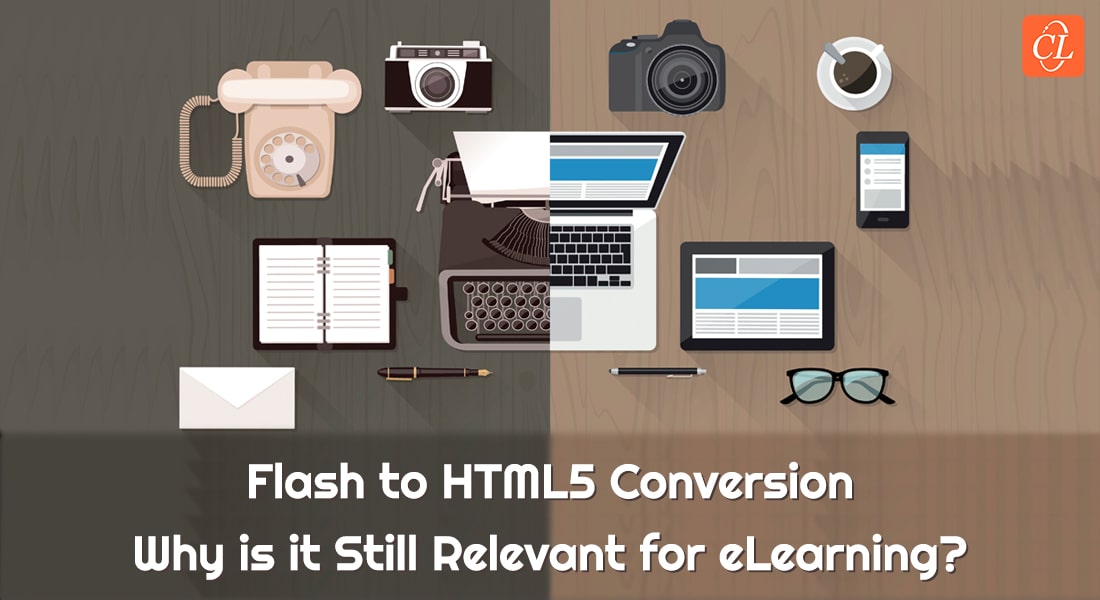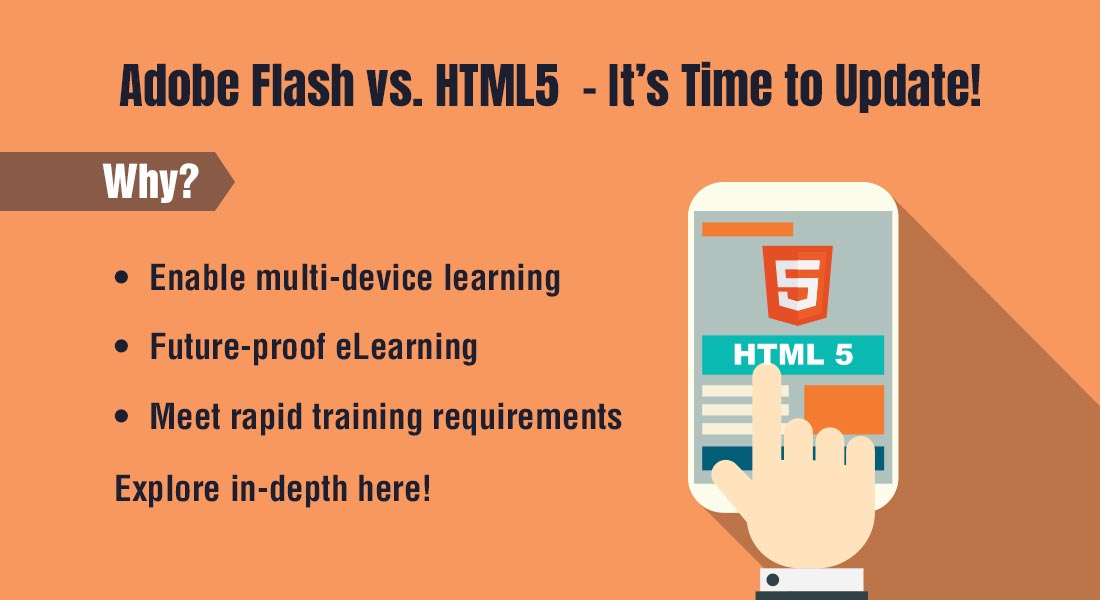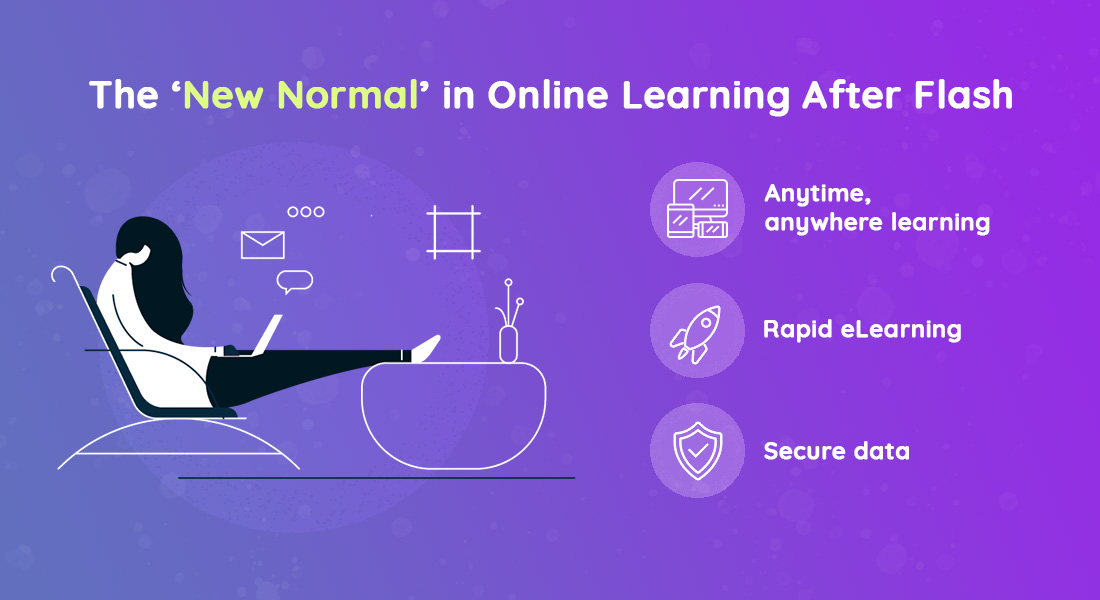Flash to HTML5 Conversion for Effective Training

After nearly two decades, Flash’s love affair with eLearning is finally coming to a close. Nowadays, Flash to HTML5 conversion is a popular eLearning trend. Over 80% of learners prefer using Google Chrome on their laptops and mobile devices. As a result, Flash’s 2020 phaseout is prompting companies to shift their online learning courses to open web technologies before they become inaccessible.
In this post, we’ll stroll down memory lane to talk about Flash and the corporate world’s transition to the Flash-less world of HTML5-based eLearning courses.
Are you planning to convert your Flash courses to HTML5?
Key benefits of transforming Flash-based courses into HTML5 eLearning courses:
- Ensures multi-device compatibility
- Helps with eLearning course translations
- Enables rapid eLearning course development
A Quick “Flashback”
Adobe Flash is a PC software released in 1996 and it has been commonly used to create, stream, and view rich multimedia content, web applications, mobile apps and games, as well as animations.
Before HTML, eLearning course developers used Flash to create corporate training courses. The popular and copyrighted Adobe ruled the digital learning world for nearly two decades. However, it is now rapidly fading away due to its lack of compatibility with mobile devices and modern browsers such as Chrome and Safari.
Since Flash was designed for the PC era, it is not able to support modern technologies found in mobile devices and browsers, including CSS, JavaScript, and HTML. Flash also came with several limitations and gaps in performance making it an increasingly less popular choice for developers. However, the final nail in its coffin was the lack of support from Apple.
From a corporate training perspective, there are more employees than we realize that use iPhones and iPads. Being unable to access eLearning courses remains the downside that Adobe hasn’t been able to overcome. Therefore, it made Flash obsolete in December 2020 and no longer offers its updates and security patches.
Flash to HTML5 Conversion: The 4Rs That Matter
Why HTML5?
If you’re wondering about the hype surrounding HTML within the eLearning world, you need to understand its essential function. HyperText Markup Language or HTML is the World Wide Web’s core markup language. Its latest version, HTML5, has been enhanced over the decades and is rapidly becoming a cost-effective, more powerful alternative to Flash.
This programming language lets developers embed multimedia content and elements directly into the HTML5 code without relaying it through a third-party code or integration. To clarify, here are the key differences between Flash and HTML5:
| Flash |
HTML5 |
| Multiple security issues, such as malware and bugs. | Fewer vulnerability issues compared to Flash, with dedicated security and regular updates. |
| Limited accessibility and flexibility. | Much more flexible and consumes less power. Supports multimedia to enable accessibility across platforms. |
| A product of Adobe that users must purchase. | Open-source and freely available. |
| Incompatible with iOS devices. | Compatible with IOS, Windows, and Android devices. |
| Not SEO-friendly as it requires the Flash Player plug-in. | Supports different Flash-like technologies for enhanced SEO. |
Benefits of Flash to HTML5 Conversion
The following are some of the key benefits of transforming your Flash-based courses into HTML5 courses:
1. Mobile Learning
According to Zippia, 75% of US employees use smartphones and other mobile devices at work. This is a pre-pandemic statistic. Today, with the emergence of remote and hybrid workplace models, the working population has seen aggressive digitalization.
For corporate training, this shift means that legacy Flash courses are rapidly becoming obsolete as the present day’s workforce is more likely to access eLearning courses on their mobile devices. This is where HTML5 comes in. It helps organizations create responsive courses compatible with all browsers, operating systems, and devices – a feature that’s not available with Flash.
2. eLearning Translation
With companies hiring remote employees or outsourcing tasks and projects to professionals in different countries, organizations are localizing their training content to meet a particular region’s linguistic and cultural needs. With Flash, organizations and course developers would have to copy training content and translate it manually.
With HTML5, you can use authoring tools, such as HTML’s translate functionality, to bridge language barriers and create content that is relevant to a specific geographic location.
3. Enable Rapid eLearning
No training manager or course developer is a stranger to working against time to rollout eLearning courses on tight deadlines. Even if you have a team capable of working day and night to develop an excellent course, you can avoid the hassle by using rapid eLearning course development tools and software.
It is possible to develop rapid eLearning courses with ease by using HTML5 eLearning authoring tools that don’t require extensive programming and coding, as is the case with Flash. Lectora Inspire, Storyline, Rise, iSpring, DominKnow One, and Captivate are all examples of eLearning authoring tools that use HTML5. A few benefits of using HTML5 eLearning authoring tools include:
- Built-in, ready-to-use, and customizable screen templates of course content, welcome messages, learning objectives, assessments, and summaries that do away with the need to design and develop eLearning courses from scratch..
- Media libraries packed with images, short videos, icons, illustrations, and characters to save time when downloading and editing course content, and creating copyrights.
- Features such as gamification and VR simulations that enhance learner engagement and interaction.
How to Convert Flash to HTML5?
Now that you have explored the benefits of Flash to HTML5 conversion, let’s find out how to convert legacy eLearning courses into their modern-day counterparts using four different strategies:
1. Record Course Content Without the Source File
This is the simplest Flash to HTML5 conversion that typically involves using an MP4recording strategy. This method comes in handy when you don’t have too many interactive elements, and your main objective is to enable learners to recall key facts and concepts.
2. Republish Course Content
This conversion strategy uses authoring tools to upgrade existing HTML5 courses into the latest version. You need to identify the key assets of your courses such as images, text, and animations that you want to re-create. Many developers simply use JavaScript to make courses that are compatible with HTML5.
3. Rebuild eLearning Courses from Obsolete Software
This conversion strategy makes legacy courses that are compatible with mobile devices by enabling compatibility across platforms using authoring software and tools. The rebuild strategy is typically used to revive Flash-based courses created by using obsolete software. The key benefits this strategy offers organizations is that it requires minor changes to content. If you have training content that doesn’t require any updates then this should be your go-to strategy.
4. Redesign Legacy Courses with New Content
This strategy comes in handy when courses require a complete revamp that includes new instructional design and content. This strategy aims to develop a brand-new course using the previous courses’ development cycle in order to change its look and feel and upgrade the content with interactive elements such as games, enhanced visuals, and clearer sound.
It’s a Wrap!
And there you have it – this is everything you need to know about Flash to HTML5 conversion. HTML5 is an open, independent, and self-updating programming language that evolves based on technological advancements and learning practices in the corporate sector. Now that you know how to convert your legacy courses to HTML5, you’re just a few steps away from creating courses that are secure, modern, workforce-friendly, and future-proof.
Refer to this eBook for further insights into how to convert your courses from Flash to HTML5.





